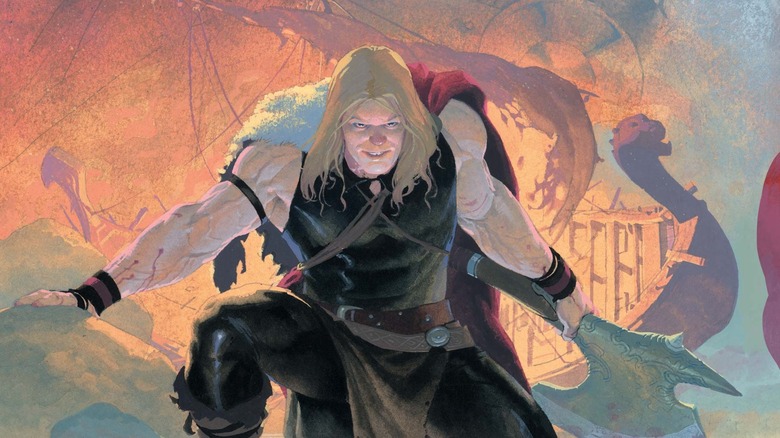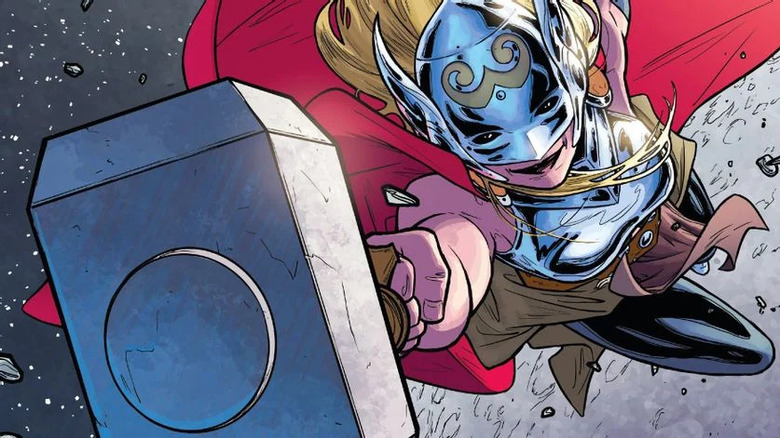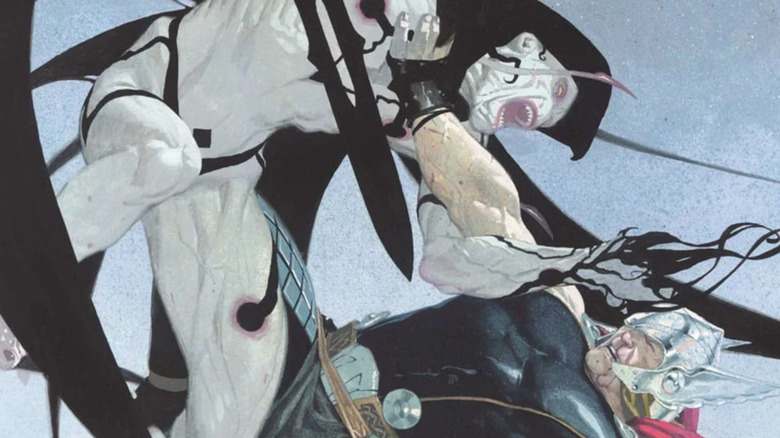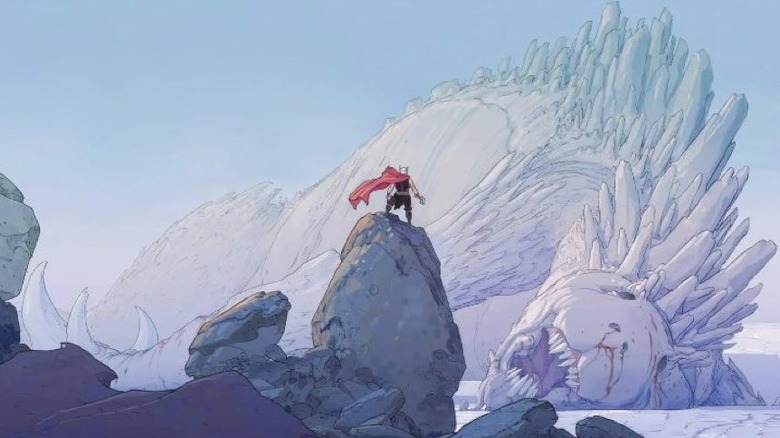The Comic Book Run You Need To Read Before Thor: Love And Thunder
The Marvel Cinematic Universe never really does direct adaptations. Though there are scenes that feel straight out of the comics, everything from "Civil War," to "Infinity War" to "Thor: Ragnarok" are very, very loose adaptations of the comic storylines that inspired them.
This brings us to the new trailer for "Thor: Love and Thunder." The trailer did a lot of things, from making Thor thin again, to deleting a major canon point from "Ragnarok," to introducing highly anticipated characters like Zeus and Jane Foster as the new Thor, and showing cool imagery like space goats pulling a Viking space boat.
These ideas are very cool, but in the comic that influenced the movie, they are the tip of the iceberg of a world of wonderfully zany ideas that make up one of the best superhero comic book runs. If you want something to prepare you for "Thor: Love and Thunder" that will make you appreciate not just the character, but what superhero comics, in general, can do, you owe it to yourself to read Jason Aaron's decade-long run on "Thor."
What it is
After working on "X-Men" and "Wolverine" for a few years, Aaron revitalized and revolutionized "Thor." His run started with a storyline that had not one, but three Thors from different points in his life fight Gorr, the God-Butcher (soon to make his live-action debut in "Love and Thunder"), a being who wants to kill every god and force mortals to depend on themselves.
From there, the run explores monumental events in the God of Thunder's life. Did you think the scene in "Avengers: Endgame" where Thor laments how much misery he's experienced in a short time, relative to the hundreds of years he's lived, was sad? Try seeing Thor lose an eye, an arm, his home, his hammer, and his powers all in the span of a single comic book run — granted, these events span hundreds of years, but still! And if you're worried about being lost or confused about the crossover with other Marvel stories, don't worry, because this run is mostly self-contained, and you can skip the rare tie-ins with larger Marvel events as the "Thor" titles fill you in on the important stuff.
But even if Aaron's run doesn't connect much with the larger Marvel universe in the comics, it has already influenced the MCU's portrayal of the character. "Thor: Ragnarok" already adapted Thor losing his eye, Mjølnir, and Asgard. Hela's quest to end Odin's bloodline for their crimes, along with making Thor doubt whether his family was worth saving feels straight out of the God-Butcher saga. But of course, the biggest contribution Aaron and his team did for the cultural zeitgeist was turning Jane Foster into the new God of Thunder, Thor, herself.
During her time as Thor, Jane had to face Loki, the rise of Malekith, and even the All-Father Odin himself, as she encountered sexism and misogyny both on Earth and Asgard.
Why it rules
Throughout the run, the comic balances different tones seamlessly, as it weaves together an epic worthy of the ancient Norse sagas. There are moments that are as metal as "The Northman," with a medieval Thor fighting alongside Vikings with an ax that could belong in Nic Cage's "Mandy," as well as sillier sci-fi things like having goats pull Viking ships in space, or modern tanks fighting space elves.
At its best, the comic challenges the idea of Thor not just as a person, or as a hero, but as a god and even a title. Splitting the narrative into three points in Thor's life — as a young hot-headed Viking, as an Avenger, and as a seasoned old king — allows the comic to humanize the God of Thunder in a way we've rarely seen the character. Gorr the God-Butcher is not just a formidable physical opponent for Thor, but the way he challenges the very idea that mortals need gods, and whether immortal beings are useful at all, is fascinating. As an immortal god, Thor is in a unique position amongst Marvel characters, being removed from smaller, mundane problems that plague mortals, and seeing him come to terms with the things he's forgotten, the friends he's lost, and the failures he's suffered, is heartbreaking at times.
But things are kicked up a notch with Jane as Thor. Jason Aaron and his team of artists tell an even more human story that touches on themes of faith, sacrifice, heroism, nobility, and more. Since Jane is a mortal that gains the powers of a god when holding Mjølnir, the comic gets to explore a totally different yet equally valid side to the character, one that truly walks in two worlds the way the character originally did when conceived by Stan Lee, Larry Lieber, and Jack Kirby.
The comic book run is unafraid to get weird, get serious, make huge changes to the canon, and tell incredibly personal and intimate stories. In many ways, it feels like a creator-owned and driven comic run, breaking from the formula and the corporate limitations to give us something that shows why people fell in love with superheroes in the first place — ranking up there with Grant Morrison's epic "Batman" run, or Alan Moore's "Swamp Thing," and Chris Claremont's "X-Men."
How it works as a comic
When the trailer for "Thor: Love and Thunder" hit, people took to social media to point out how the trailer directly lifts a shot from Aaron's comic, while failing to properly translate Esad Ribic's art and Iva Svorcina's coloring. If the plot of Aaron's run challenged what a Thor story could be, then the artists that worked on the run made sure the story was imprinted in your brain long after you closed the book (or the digital app).
Though not as photorealistic as Alex Ross' art, Ribic and Svorcina give the early storylines a sense of lush yet grounded realism that fits the medieval tone of the story, while channeling the works of Moebius in the coloring. Even when the comic changed artists and Russell Dauterman and Matthew Wilson took over, the painterly style changed to a shinier and more modern look that fit Jane's more adventurous and relatively upbeat story.
For almost a decade, Jason Aaron and a team of brilliant artists gave us one of the best superhero runs in years, one that revolutionized the character of Thor, and which you definitely need to read before Marvel loosely adapts this story.
"Thor: Love and Thunder" is set to hit theaters on July 8, 2022.



